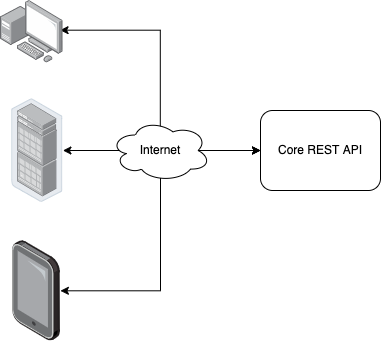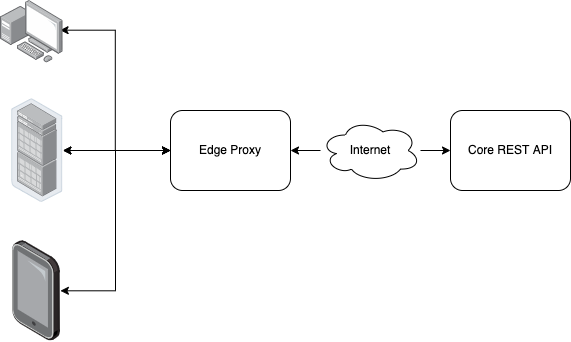Edge Proxy
The Flagsmith Edge Proxy allows you to run an instance of the Flagsmith Engine close to your servers. If you are running Flagsmith within a server-side environment and you want to have very low latency flags, you have two options:
- Run the Edge Proxy and connect to it from your server-side SDKs
- Run your server-side SDKs in Local Evaluation Mode.
The main benefit to running the Edge Proxy is that you reduce your polling requests against the Flagsmith API itself.
The main benefit to running server side SDKs in Local Evaluation Mode is that you get the lowest possible latency.
How does it work
The Edge Proxy has the same caveats as running our SDK in Local Evaluation mode..
You can think of the Edge Proxy as a copy of our Python Server Side SDK, running in Local Evaluation Mode, with an API interface that is compatible with the Flagsmith SDK API.
The Edge Proxy runs as a lightweight Docker container. It connects to the Flagsmith API (either powered by us at api.flagsmith.com or self hosted by you) to get Environment Flags and Segment rules. You can then point the Flagsmith SDKs to your Edge Proxy; it implements all the current SDK endpoints. This means you can serve a very large number of requests close to your infrastructure and users, at very low latency. Check out the architecture below.
The Proxy also acts as a local cache, allowing you to make requests to the Proxy without hitting the core API.
Performance
The Edge Proxy can currently serve ~2,000 requests per second at a mean latency of ~7ms on a single, 4-core VM. It is stateless and hence close to perfectly scalable being deployed behind a load balancer.
Configuration
The Edge Proxy can be configured using a json configuration file (named config.json here).
You can set the following configuration in config.json to control the behaviour of the Edge Proxy:
- environment_key_pairs: An array of environment key pair objects, e.g:
"environment_key_pairs":[{"server_side_key":"your_server_side_key", "client_side_key":"your_client_side_environment_key"}] - [optional] api_poll_frequency(seconds): Control how often the Edge Proxy is going to ping the server for changes,
e.g:
"api_poll_frequency":10 - [optional] api_url: If you are running a self hosted version of flagsmith you can set the self hosted url here for
edge-proxy in order to connect to your server, e.g:
"api_url":"https://self.hosted.flagsmith.domain/api/v1"
After setting up the above configuration the config.json is going to look something like this:
{
"environment_key_pairs": [
{
"server_side_key": "your_server_side_environment_key",
"client_side_key": "your_client_side_environment_key"
}
],
"api_poll_frequency": 10,
"api_url": "https://api.flagsmith.com/api/v1"
}
Environment Variables
You can configure the Edge Proxy with the following Environment Variables:
WEB_CONCURRENCYThe number of Uvicorn workers. Defaults to1. Set to the number of available CPU cores.
Running the Edge Proxy
The Edge Proxy runs as a docker container. It is currently available at the Docker Hub.
With docker run
# Download the Docker Image
docker pull flagsmith/edge-proxy
# Run it
docker run \
-v /<path-to-local>/config.json:/app/config.json \
-p 8000:8000 \
flagsmith/edge-proxy:latest
With docker compose
version: '3.9'
services:
edge_proxy:
image: flagsmith/edge-proxy:latest
volumes:
- type: bind
source: ./config.json
target: /app/config.json
ports:
- target: 8000
- published: 8000
The Proxy is now running and available on port 8000.
Consuming the Edge Proxy
The Edge Proxy provides an identical set of API methods as our Core API. You need to point your SDK to the Edge Proxy domain name and you're good to go. For example, lets say you had your proxy running locally as per the instructions above:
curl "http://localhost:8000/api/v1/flags" -H "x-environment-key: 95DybY5oJoRNhxPZYLrxk4" | jq
[
{
"enabled": true,
"feature_state_value": 5454,
"feature": {
"name": "feature_1",
"id": 2,
"type": "MULTIVARIATE"
}
},
{
"enabled": true,
"feature_state_value": "some_value",
"feature": {
"name": "feature_2",
"id": 9,
"type": "STANDARD"
}
},
]
Monitoring
There are 2 health check endpoints for the Edge Proxy.
SDK Proxy Health Check
When making a request to /proxy/health the proxy will respond with a HTTP 200 and {"status": "ok"}. You can point
your orchestration health checks to this endpoint. This endpoint checks that the Environment document is not stale, and
that the proxy is serving SDK requests.
Realtime Flags/Server Sent Events Health Check
If you are using the Proxy to power Server Sent Events for realtime flag updates. When making a request to /sse/health
the proxy will respond with a HTTP 200 and {"status": "ok"}.
Managing Traits
There is one caveat with the Edge Proxy. Because it is entirely stateless, it is not able to persist Trait data into any
sort of datastore. This means that you have to provide the full complement of Traits when requesting the Flags for a
particular Identity. Our SDKs all provide relevant methods to achieve this. An example using curl would read as
follows:
curl -X "POST" "http://localhost:8000/api/v1/identities/?identifier=do_it_all_in_one_go_identity" \
-H 'X-Environment-Key: n9fbf9h3v4fFgH3U3ngWhb' \
-H 'Content-Type: application/json; charset=utf-8' \
-d $'{
"traits": [
{
"trait_value": 123.5,
"trait_key": "my_trait_key"
},
{
"trait_value": true,
"trait_key": "my_other_key"
}
],
"identifier": "do_it_all_in_one_go_identity"
}'
Note that the Edge Proxy will currently not send the Trait data back to the Core API.
Architecture
The standard Flagsmith architecture:

With the proxy added to the mix:
